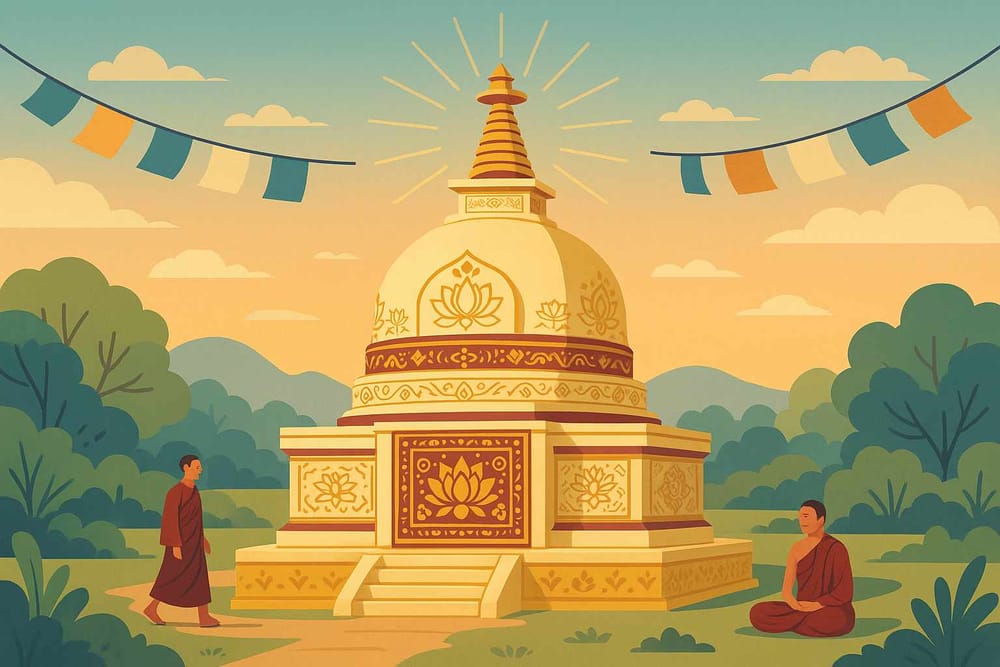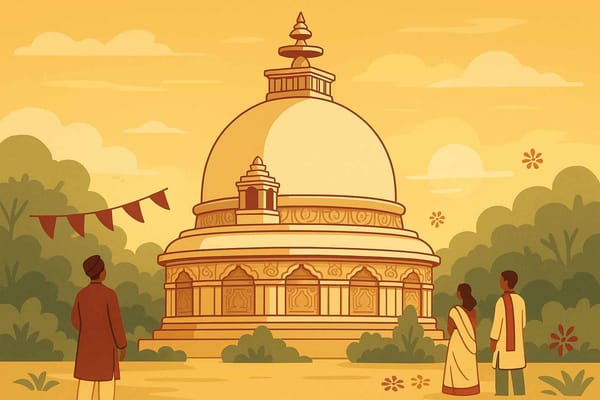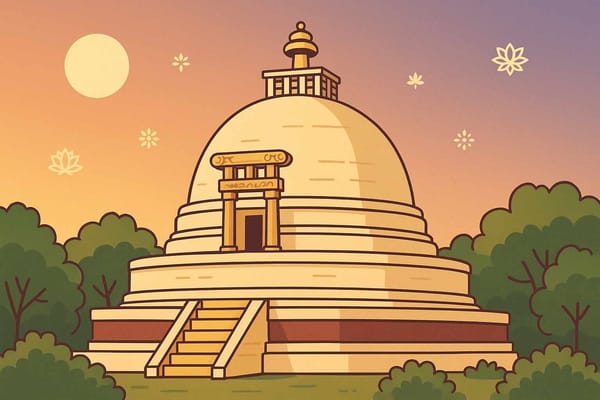
Dharmarajika Stupa- History Reveals Significance
Some places in the world don't just exist in the present; they carry the whispers of centuries within their very stones. Imagine standing on ground that witnessed a great emperor's change of heart, a place where the message of peace was shaped into a magnificent structure. This is the feeling that surrounds the Dharmarajika Stupa in Taxila, a timeless monument that tells a story not just of Buddhism, but of humanity's search for inner harmony.
Its story begins with one of India's most legendary figures, Emperor Ashoka. After the heart-wrenching Kalinga war in the 3rd century BCE, Ashoka’s life took a profound turn. He turned away from conquest and embraced the path of Dharma. His mission was to spread the teachings of Lord Buddha, and he chose to do so by building stupas—sacred mounds—to house the Buddha's holy relics. The Dharmarajika Stupa is one of the most significant of these, a powerful symbol of his transformation.
From an Emperor's Vision to a Beacon of Faith
Taxila was no ordinary city. In those ancient times, it was a bustling hub of knowledge and culture, a place where scholars and seekers from all over the world gathered. Placing the stupa here was a masterstroke. It became a spiritual anchor in a sea of learning, attracting pilgrims and monks who helped preserve and spread Buddhist philosophy along the famous Silk Road.
Archaeological evidence suggests that this stupa was built over an even older one, amplifying its sanctity. It was more than just a monument; it was a relic depository, built with the sacred purpose of enshrining fragments of the Buddha's own remains. Finding such a place is like finding a direct connection to the enlightened one himself, a thought that still fills devotees with awe.
An Architecture of the Soul
The design of the Dharmarajika Stupa is a beautiful lesson in Buddhist cosmology. It's not merely a structure; it's a spiritual map. The large, hemispherical dome represents the vast, endless universe, a symbol of boundless wisdom. The circular path around it invites devotees to perform pradakshina, a meditative walk that helps focus the mind and show reverence.
Over the centuries, especially during the Kushan era, the complex grew. A grand staircase was added, and smaller stupas and monasteries bloomed around the main structure, creating a vibrant spiritual community. The art found here, a unique blend of Indian and Greco-Roman styles known as Gandhara art, tells stories of a world where cultures met and created something beautiful together. This reminds us of how spiritual sites across India, like the majestic temples of Rajasthan, blend divine purpose with incredible artistry.
A Legacy of Resilience and Rediscovery
The journey of the Dharmarajika Stupa has not been without its trials. It faced destruction at the hands of the Huns in the 5th century CE and suffered further damage over time. For centuries, its true glory lay buried, waiting to be rediscovered. It was a heart-wrenching chapter in its history, but its spirit was never extinguished.
Then, in the early 20th century, archaeologist Sir John Marshall and his team began excavations that brought its stories back to light. They unearthed incredible treasures—relics, sculptures of Bodhisattvas, and images of the Buddha. It was as if the earth was giving back a piece of our forgotten heritage. This rediscovery cemented its status, and today, as part of the Ruins of Taxila, it is a protected UNESCO World Heritage Site, a treasure for all of humanity.
Understanding the Dharmarajika Stupa Better
Many people have questions about this sacred site, so let's explore some of them. At its core, the Dharmarajika Stupa is an ancient Buddhist monument, one of the earliest of its kind, created to safeguard the precious relics of Lord Buddha. Its significance is immense because it’s not just an archaeological wonder but a living center of spiritual energy that showcases the spread of Buddhism in ancient times.
The vision behind this grand structure belongs entirely to Emperor Ashoka of the Mauryan Dynasty, who built it as an act of devotion. When you look at its design, you see more than just architecture; you see symbolism in its hemispherical dome and circular base, all surrounded by what was once a thriving monastic complex. The very heart of the stupa holds its most sacred secret—relics believed to be bone fragments of the Buddha, making it a place of profound pilgrimage.
Recognizing its immense cultural value, it has been rightfully designated as a part of the Taxila UNESCO World Heritage Site since 1980. And for those who wish to walk this ancient path, the site is open, offering a tangible connection to our past. Visiting this place is more than a tour; it's a spiritual journey because it connects you to the timeless teachings of the Buddha and the deep history of our land, much like a journey through the historical and spiritual sites of Udaipur can connect you to the soul of Mewar.
About Bhaktilipi
At Bhaktilipi, we believe that stories of faith, history, and devotion are the threads that weave our cultural fabric. We are a digital space dedicated to sharing timeless devotional literature and spiritual wisdom in a way that resonates with today’s world. If the story of the Dharmarajika Stupa inspires you, imagine the ocean of knowledge that awaits.
Why Explore with Us?
- Learn about deep-rooted traditions. We help you understand the relevance of ancient practices and spiritual sites in modern life, connecting you to your heritage in a meaningful way.
- Discover sacred texts and inspiring stories. We bring you carefully curated literature, from scriptures to devotional poetry, in both original languages and easy-to-understand translations, making wisdom accessible to all.
Stay connected with us for more reflections on devotion, history, and the spiritual path. Subscribe to our newsletter or follow us for your daily dose of inspiration.
Follow Bhaktilipi:
Facebook | Instagram | YouTube
Conclusion: A Timeless Message of Peace
The Dharmarajika Stupa is more than a historical ruin; it is a standing testament to the power of peace and compassion. Born from an emperor's vow to choose non-violence, it has survived the tests of time to remind us of the timeless teachings of Lord Buddha. Its architectural grace and spiritual depth make it a place where history breathes and the soul finds quiet.
Reflecting on its journey, we see a bridge between our past and our present, a reminder of the values that can guide us even today. Whether you are a seeker of spiritual truth or a lover of history, this sacred stupa offers a profound connection to a legacy of wisdom that belongs to us all. By cherishing such monuments, we keep their stories, and their blessings, alive for generations to come.
A passionate group of people dedicated to preserving India's knowledge of Dharma, Karma, and Bhakti for ourselves and the world 🙏.
Comments
Related in

Dharmarajika Stupa: Journey Through History
Have you ever stood in a place so ancient that you can almost hear the whispers of history in the wind? A place where the stones themselves seem to tell stories of emperors, monks, and seekers from centuries ago. One such place is the magnificent Dharmarajika Stupa, nestled near Taxila

Dharmarajika Stupa- History's Journey Explores Mysteries
Have you ever felt the pull of a place you’ve never visited? A place where history isn't just in books, but whispers from the very stones themselves. For me, the Dharmarajika Stupa in Taxila, now in Pakistan, is one such place. It’s a silent witness to

Dharmarajika Stupa- History Reveals Significance
Have you ever thought about how some stories are so powerful they refuse to be confined by maps or borders? They travel through time, carried in the hearts of generations. One such story is that of the Dharmarajika Stupa, a monumental echo of faith that stands not in India, but
